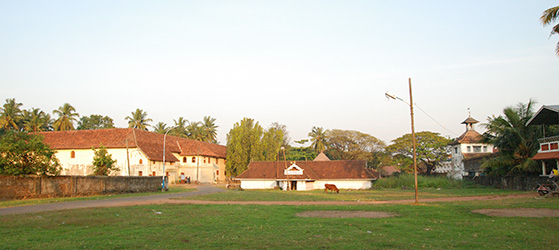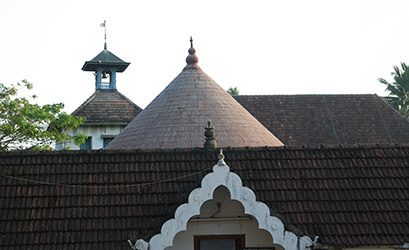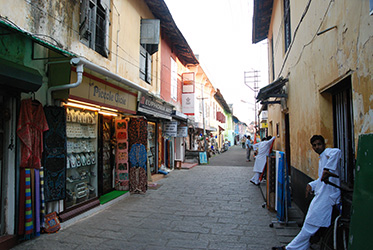This is an article about the Jewish connection that the Cochin Royal Family had in the past. This article / letter was first written by me for the benefit of the readers of
Gosri Visesham, a monthly publication put out by the Cochin Royal Family for its members. Representatives of an International Jewish Organization, the B’nai B’rith were to visit India in February 2005. They were going to be in Kerala for three days and had requested an audience with the members of the Erstwhile Cochin Royal Family. This was to be an event purely for the members of the family.
The B’nai B’rith is an International Jewish Organisation with tremendous reach, which does inspiring work in issues on human rights, in addition to their Semitic interests. Their own research had convinced them that the Jewish experience in Cochin is unparalleled in history. It was after much thought and consideration of the historical facts that the International Jewish Diaspora decided to recognize and honor the ancestors of the Cochin Royal Family with a 'Humanitarian Award'. It was only proper for us to accept them with honor and dignity. We have done it in a very private setting but with the kind of pageantry we like.
[
The letter has been edited for inclusion in this web site.]
- Kocha Varma.
A video clip of the B'nai B'rith's visit to Tripunithura...CLICK HERE
The early history of Jews in Kerala is shrouded in obscurity. There is ample evidence to support the conclusion that trade existed between the East and the West even prior to King Solomon’s time(973B.C). References to the presence of sandalwood, ivory and peacock feathers in the Jewish Temple, built by King Solomon, attests to this early contact. The first Jews who arrived on the Malabar Coast are presumed to have travelled on King Solomon’s merchant fleet. Thereafter, waves and waves of Jewish migration took place and the present Kodungallor was the place they settled( Musiris, the famous port near Kodungalloor, under the control of Perumals, the early rulers of the Chera Empire was thriving with traders from Persia, China and the present Middle East.). These migrations correspond with the fall of the Assyrian Empire in 600 B.C., the conquest of Judea by Babylon in 586 B.C., the conquest of Babylon by the Cyrus of Persia in 539 B.C. and certainly after the destruction of the Second Temple in 68 A.D. Legend has it that St.Thomas was brought in by a Jew in 52 A.D. and actually stayed in the Jewish quarters in Kodungalloor. He is said to have baptized more than 40 Jews in that area.
The Jews in Kodungallor were treated well by successive Hindu Kings and either the reigning Perumal or his immediate successor Bhaskara Ravi Varma ceded some territories called Anjuvanom and several privileges were bestowed upon the Jewish community. This deed has been engraved on copper plates in vattezhuthu and is estimated to have been in sometime in the 10
th century. They are kept in the Paradesi Synagogue in Cochin.
The text as translated reads:
Hail! Prosperity! This is the gift that His Majesty, the King of Kings, Sri Bhaskara Ravi Varman , who is to wield the scepter for several thousand years, was pleased to make during the thirty-sixth year after the second year of his reign on the day when he was pleased to reside at Muyirikkodu(Musiris).
We have granted the Anjuvannam to Issuppu Irappan, tolls by boat and other vehicles. Anjuvannam dues, the right to employ a day lamp, decorative cloth, a palanquin, an umbrella, a kettle drum, a trumpet, a gateway arch, an arched roof, weapons and the rest of the seventy two privileges. We have remitted custom dues and the weighing fee.
Moreover, according to this copper plate grant, he shall be exempted from payments due to the King from(other) inhabitants of the town,but he shall enjoy(the benefits) that they enjoy. To Issuppu Irappan of Anjuvanam, his male and female issues, nephews and sons-in-law, Anjuvannam shall belong by hereditary succession as long as the world and moon endure.
Prosperity!
This is attested by
---Govarthana Marthandan, Governor of Venadu.
---Kota Jirikantan, Governor of Vempalinadu.
---Manavepala Manaviyan, Governor of Eralanadu.
---Rayiran Chathan, Governor of Valluvanadu.
---Kota Ravi, Governor of Nedumpurayurnadu.
---Murkan Chathan, Commander of the Eastern Forces.
This writing was executed by Vanralacheri Kandan Kunrappolan, the officer who takes down oral messages
Various points of this translation is subject to analysis and confusion. The Dutch Governor, Moens writes in Galletti, 192-8 that he had translations of the plates made by a jew( Ezekiel Rahabi ), an Indian and a Dutchman, but that the translations did not match. Gundert has reproduced a Hebrew translation of the plates. Even though translations vary, its content has remained undisputed. Narayanan and Kunjan Pillai, in their respective studies. suggest that temple inscriptions indicate that Bhaskara Ravi Varma was a Chera King who came to the throne in 962 and that one of the signatories; the Governor of Venadu, assumed power in 976. A Perumpadappu signature was absent because the donor, Bhaskara Ravi Varma, a Perumal, was his direct ancestor.
In 1341, a cataclysmic movement of the sea created an excellent harbour at Cochin and the silting of the Musiris/Kodungallor harbour that ensued as its result, brought the Jewish settlement to Cochin. The Cochangadi(Cochin Market) synagogue was built in 1345. The early Jewish migrants intermingled and married natives, resulting in a group known as the Black Jews. The later set of massive immigration took place from Spain and Portugal and they were fair-skinned Europeans who maintained their ethnicity.
Perumpadappu Swaroopam, descendants of the Perumals, moved to Cochin in 1405 to escape from the attacks of the Zamorin. In 1500, Cabral sailed into Cochin and that marks the arrival of the Portuguese.
The Jews enjoyed freedom and prosperity under a certain degree of autonomy for hundreds of years in the Chera Kingdom (present-day Kerala).
A time came when an internal squabble erupted, reulting in open hostility between two Jewish brothers who were vying for the Chieftainship of Anjuvanom. Zamorin, the ruler of Calicut, got involved and in its aftermath, a lot of pillaging and destruction occurred. In 1524, in the pretext that the Jews were tampering with the spice trade, the Moors, with Zamorin’s help, destroyed the Jewish settlement and the Synagogues. Hundreds of years of tolerance and mutual co-existence were suddenly shattered. The Jews left Anjuvanom and fled to Cochin. In Cochin, the Jews were placed under the protection of the Raja of Cochin. To quote the words of an English writer, 'with a liberality that can be hardly understood, he granted them a site for a township by the side of his own Palace and Family Temple.' Jew Town was built on this site in 1567 and the famous Paradesi Synagogue was built in 1568. For the next 400 years, the Cochin State and the Jews of Cochin enjoyed a mutually tolerant and enlightened existence.

The Portuguese Period
During the Portuguese Period of Cochin History, for almost 160 years, the Jews were terribly victimized. It is said that the Portuguese came to India with a sword in one hand and a cross in the other. The period of Spanish Inquisition was just beginning. To quote the late Jewish leader of Cochin, SS Koder 'The spirit of the time is seen from a letter written in 1513 by Albuquerque in which he brought to the attention of the King of Portugal, the existence of large influx of Portuguese and Castilian Jews and enquired of His Majesty, "whether I may be permitted to exterminate them one by one". The Portuguese not only completed the destruction of the already shattered settlement in Cranganore but also sacked Jew Town and partially destroyed the famous Paradesi Synagogue in 1661.'
Yet, the 16
th and 17
th centuries were an era of building Synagogues. According to Dr Kenneth Robbins’ research,
1. Kochangadi Synagogue built in Ft Cochin around 1400. This was ruined and in its place was built the Kadavaumbagum Synagogue.
2. Kadavumbagam in Cochin in 1539 – 49.
3. Thekkumbagam in Ernakulam in 1580.
4. Mala in 1597.
5. Chennamangalam in 1612.
6. Parur, rebuilt in 1616 and
7. Thekkumbagam of Cochin in 647 - 87.
'

The Hindu Temple and the Synagogue in Fort Cochin
'

A view of the Jew Street in Fort Cochin
To quote Dr Robbins : 'The Jews have been allied with the Rajas of Cochin for hundreds of years. The Rajas befriended, protected and favoured the Jews. The Jews were allowed to openly practise their religion. In 1636, the Inquisition wanted to persecute the Jews in the Raja’s realms. They were prevented by the Portuguese Viceroy who feared that the Raja’s displeasure would affect the price of pepper.'
In 1662, the Dutch, with help from the Mootha Thavazhi, attacked Cochin. The Jews supported them. The Portuguese burnt down the Paradesi Synagogue and destroyed the place, along with the Community History Records kept in the Synagogue. The Dutch hegemony, that is, the period from 1663 to 1797, saw the rise of the second golden age of the Jews of Cochin. The entire trade was in the hands of the Jews. The Dutch East India Company and the Ruler of Cochin benefited from the important role played by the Jewish merchants at that time. Prominent among the Jewish merchants then was, Ezekiel Rahabi, who had contact with all the European powers that were in India. He is also said to have maintained friendly transactions with the Muslims, the Parsis and the Hindus.
The British Period
In 1795, Cochin passed into the hands of the British under whom the Jews continued their peaceful existence in Cochin.
To paraphrase J.B Segal in 'A History of the Jews of Cochin’ :
The Dutch settlement in Cochin was concentrated in Fort Cochin or Dutch Cochin. There were Jews, Christians and Konkinis who were the Raja’s subjects, living there, helping the Dutch with their trade activities. They came under the jurisdiction of the Dutch but, their security was under the Raja’s control. When the British defeated the Dutch, the British took control of Fort Cochin.
In 1800, Raja Rama Varma Shakthan Thampuran wrote to Jonathan Duncan, the Governor of the Bombay Presidency : ' - it appears that the Jews are under the protection of the company and they should not come to the Raja for anything, and that placards have been exhibited to this effect at four places including Mattanchery and Jew Town. - ' The Raja had judged a dispute between some Jews and pronounced his verdict. ' - yet three Jews involved in this dispute are now shut up in the British Fort. - ' The Raja continued ' - Since the Jews are our special tenants and subjects, they were ( centuries ago) given land to settle down and all their grievances were redressed by us and we have been doing this for years, following the tradition of our ancestors. Therefore, we request you to get the placards removed and to release( the three Jews) from the Fort and to allow us to carry on with the functioning of the Government as usual.' In 1803, in a letter to the British, the Raja repeated his objections. ' - whenever we had a royal festival at our court, the Jews, as usual, would come and pay homage to us. But since(the British Government) has forbidden the Jews from having any dealings with us, they have not come to us for the festivals and they have not done anything to custom and precedent.'
Duncan Saip never understood the point of view of the Raja and eventually, Shakthan Thampuran lost out.
The next Raja, Veera Kerala Varma, during the Residency of John Munro, wrote to the British :
'I would like to let you know that everything should be as it was during the Dutch occupation of Cochin. If you want to see the terms of the treaties which we had signed with the Dutch, we will send you copies of these treaties. When you read all the above-mentioned documents, you will understand that things should go on as before. As the Jews are our subjects and as they used to tell us about everything they wanted, we desire that even in the future, things should continue as the they did in the past. We have not entered into any(new) treaties with the English Company at Fort Cochin.'
As the British and the Indians vied with each other for the privilege of protecting the White Jews, the Jews themselves showed a preference to stay under the Raja. For example, in 1817, the Jews had been instructed to compile a detailed census of themselves and submit it to the British Court. They argued that they could not comply with this request without the consent of the Raja. The British then required them to sign a statement saying that they had refused on the advice of the Raja. They responded that the Jews of Cochin owed a debt of gratitude to the rulers of Cochin. It was the 'great ancestor' of the Raja who had assigned them land for their settlement and for the construction of their Synagogue, and it was his forbearers who had protected them for generations. Nevertheless, the leaders of the White Jews were detained by the British at the Fort for twelve days. They were released only after signing a document agreeing to comply with the authorities. Later, the Jews asked the Raja, their ‘sole protector’, to recover the document and ‘save them from humiliation’.
John Monro, the Resident and Dewan of Cochin from 1811 to 1818, while introducing numerous reforms, understood the financial merits of the tug of war over minorities. He argued that they should be paying taxes to the Raja since the Raja was paying the British as per their joint treaty and was entitled to the revenues of his land. Initially, the British gave over the control of these minorities(Konkinis and Christians, but not the White Jews) to the Cochin Sirkar.
The Raja of Cochin continued to assert his traditional prerogative and authority over the Jews, against both the hegemonic European powers - the Dutch and the British. In 1900, Lord Curzon, the British Viceroy visited the Paradesi Synagogue and in a letter to the Elders, wrote, "I rejoice to think that under the enlightened administration of His Highness the Raja of Cochin, you now profit by a toleration similar to that which you would have enjoyed were you residents in the dominions of the British Sovereign.”
J.B Segal, Professor Emeritus of Semitic Languages at The University of London, in his book,
A HISTORY OF THE JEWS IN COCHIN states :
'This is a story – told as far as possible in the words of contemporary observers – of a minuscule community on the Spice Coast of South-West India that maintained a vigorous Jewish existence throughout at least two millennia. Submerged among myriads of non-Semitic people, in bad times and good, whether amid the terror of the iniquitous Portuguese Inquisition or under the liberal regime of the Netherlanders, the Jews of Cochin never wavered in their loyalty to Judaism and their friendship with their Indian neighbors.'
In 1948, as most of the Jewish community of Cochin prepared to leave for the newly-founded nation of Israel, the Last Raja of Cochin, Pareekshith Thampuran, came to the Paradesi Synogogue in Fort Cochin to bid farewell to the Jewish community, paying tribute to the close association between the Royal Family of Cochin and the Jews of Cochin.
'The ties of friendship between your community and the Royal family only grew only stronger and closer in the course of time. It may interest you to know that my Grandmother used to tell us of the very pleasant hours that she and the other Princesses of her age spent in the company of your womenfolk who usually gathered at the Palace during the afternoon. The Paradesi Synagogue is a standing monument of the religious toleration and hospitality that prevailed in this part of the country from time immemorial. It is a thing of beauty and an architectural achievement in itself, a clear and visible evidence of the material prosperity and progress attained by your community under the kind patronage of the Royal family ever since you came here as the honored guests of the people.
No other people deserved such treatment better. You have, on occasions more than once, shown your unflinching loyalty to the King and the country that adopted you and gave you shelter. Of course, your community is small, but its historical importance is really great. The prosperity of the State and welfare of the people, irrespective of caste, community or color, shall always be uppermost in my mind, and I shall endeavor to promote them to the best of my abilities.
It is very gratifying for me to learn that your co-religionists are now celebrating their national freedom in Palestine, the original home of your forefathers, and I heartily congratulate you on this very happy occasion.'
A Cochin postal stamp, with the picture of the Cochin Paradesi Synagogue, was made ready for publication. But the New Government of India opted to release the same stamp as a Government of India stamp, later.


